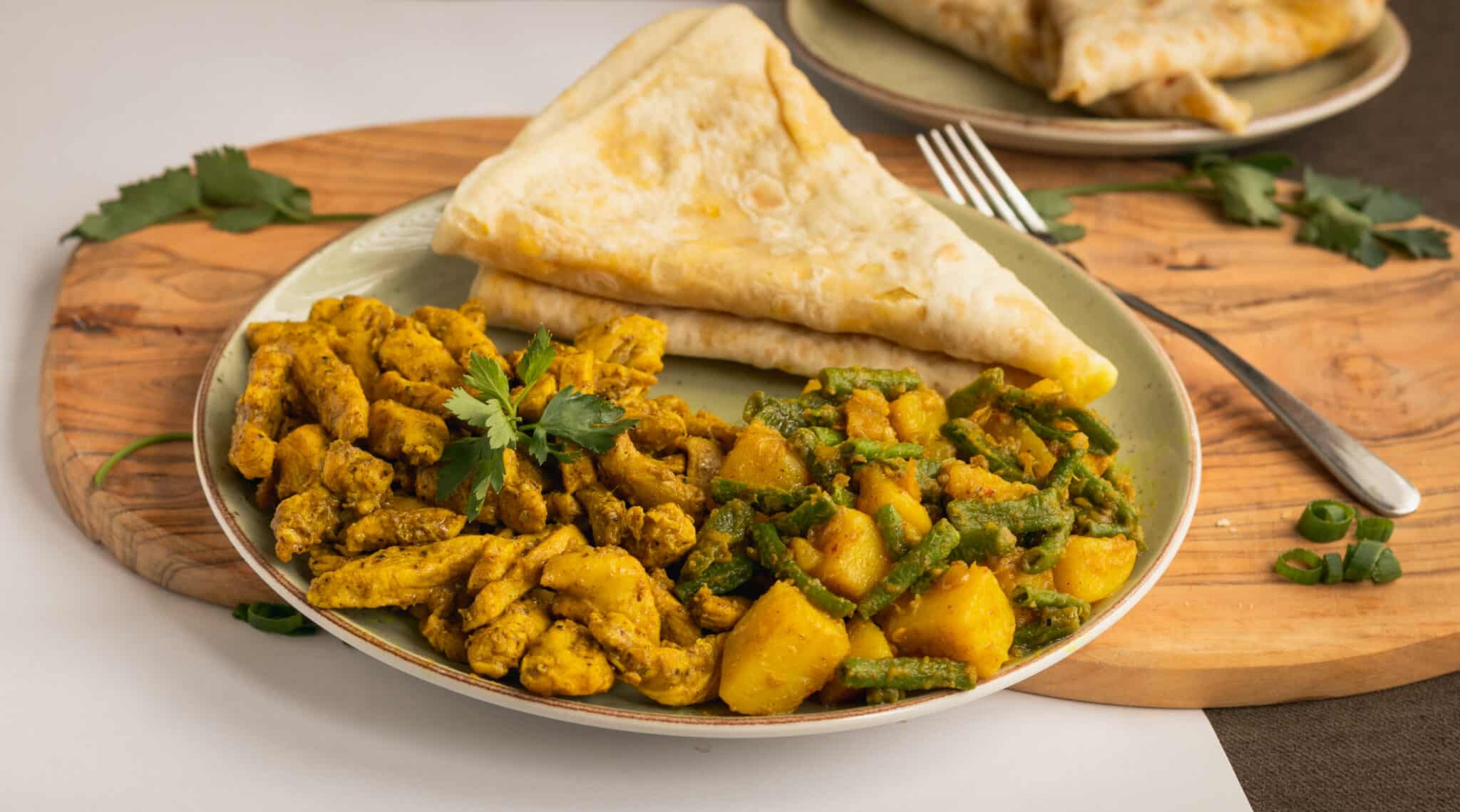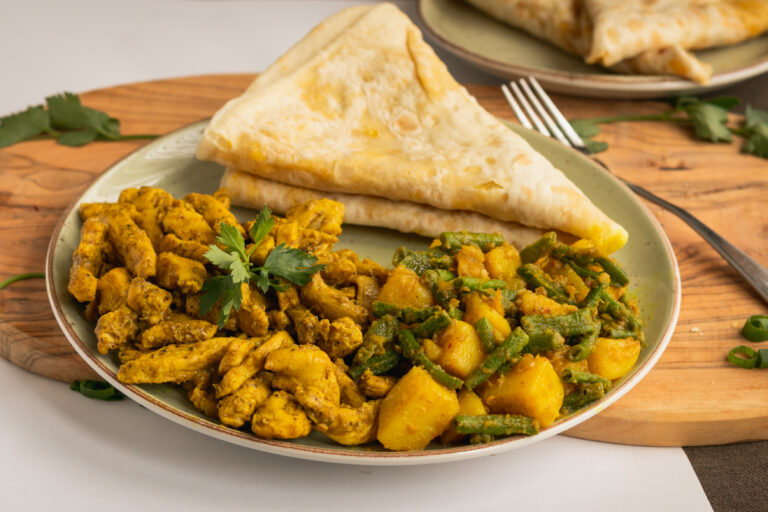
Roti, a fundamental dish in Suriname, transcends mere sustenance; it symbolizes the country’s vibrant cultural heritage. Originating from Indian cuisine, this dish has been warmly embraced and creatively adapted by the Surinamese, resulting in a unique culinary masterpiece that mirrors their diverse influences.
The story of roti in Suriname is one of migration, adaptation, and fusion. It’s an edible testament to the resilience and creativity of the Surinamese people. Let’s delve into this fascinating journey.
For all the food enthusiasts out there, our Remitly team has crafted this guide as part of our series celebrating the culinary delights of our customers around the world.
The Origin of Roti in Suriname
Roti made its way to Suriname through Indian indentured laborers brought by Dutch colonizers in the 19th century. These workers came from regions where roti was a dietary staple. They carried with them not only their skills but also their culinary traditions.
While the term “roti” officially denotes the flatbread component of this meal, originating from India, in Suriname, it has come to signify the entire dish. This encompasses not only the flatbread but also the curry, potatoes, vegetables, and often chicken. In Suriname, green beans are commonly used as the vegetable component.
Today, Surinamese roti has ventured far from its place of origin, winning over admirers worldwide. From the Netherlands to the United States, diverse communities have wholeheartedly adopted this culinary delight.
Ingredients and Preparation
Surinamese roti is versatile. It consists of roti bread and a flavorful curry sauce with ingredients like potatoes, chicken, or other proteins, as well as vegetables like green beans. Spices and fresh herbs garnish it, and condiments like sambal add extra flavor and heat.
In some regions, variations exist. Coconut milk might be added for a richer flavor, or spices like cumin or turmeric included in the dough for complexity. However, one constant remains: the deep appreciation for this humble bread.
Compared to its Indian counterpart, Surinamese roti uses wheat flour with leavening agents like baking powder or yeast for the dough. It’s rolled out into thin rounds and cooked on a hot griddle until golden brown on both sides. This results in a sturdy yet soft bread, ideal for holding fillings or scooping up curries.
A Simple Surinamese Roti Recipe
Would you like to try this delight? Here’s a simple recipe to help you make your own Surinamese roti at home.
Ingredients:
- 4 pieces of roti bread (you can find them in stores or make your own)
- 1 pound of boneless chicken, cut into bite-sized pieces (you can also use shrimp, tofu, or other proteins)
- 4 medium-sized potatoes, peeled and diced
- 1 cup of green beans (kousenband), cut into 2-inch pieces
- 1 onion, finely chopped
- 3 cloves of garlic, minced
- 2 tablespoons of vegetable oil
- 2 tablespoons of Surinamese curry powder (or more to taste)
- 1 teaspoon of ground cumin
- 1 teaspoon of ground coriander
- 1/2 teaspoon of ground turmeric
- Salt and pepper to taste
- Fresh cilantro or parsley for garnish
- Sambal or pickled vegetables for serving (optional)
Instructions:
- Heat the vegetable oil in a large skillet or pan over medium heat. Add the chopped onions and minced garlic and sauté until they become translucent.
- Add the chicken (or your choice of protein) to the skillet and cook until it’s no longer pink and has a golden brown color.
- Stir in the Surinamese curry powder, ground cumin, ground coriander, ground turmeric, salt, and pepper. Cook for a few minutes to toast the spices and create a fragrant curry base.
- Add the diced potatoes and green beans to the skillet. Stir everything together to coat the vegetables and protein with the curry mixture.
- Pour enough water into the skillet to cover the ingredients, reduce the heat to low, and cover the pan. Let it simmer for about 20–25 minutes, or until the potatoes are tender and the sauce has thickened.
- While the curry is simmering, warm the roti bread according to the package instructions or your preferred method.
- Once the curry is ready, taste and adjust the seasoning if needed.
- Serve the Surinamese roti by placing a piece of roti bread on a plate, spooning the curry mixture over it, and garnishing with fresh cilantro or parsley. You can also serve it with sambal or pickled vegetables on the side for extra flavor.
How to Enjoy a Traditional Surinamese Roti Meal
A traditional Surinamese roti meal is a sensory delight. It typically features roti accompanied by curries, which can be made with chicken, beef, or vegetables. ‘Kousenband,’ long beans cooked with garlic and tomatoes, is a popular side dish.
The eating experience involves tearing off a piece of roti and using it to scoop up the curry—no utensils required! This hands-on approach enhances the meal, making each bite feel personal and gratifying.
Roti isn’t just for every day; it’s a festive treat for Surinamese celebrations like weddings and religious festivals. Families gather to make plenty of rotis together, forging strong bonds among them. Sharing roti symbolizes love and hospitality, extending a warm welcome to guests in one’s home.
The Broader Cuisine of Suriname
Surinamese cuisine is as diverse as its people—a melting pot of flavors influenced by Indian, African, Indonesian, Chinese, Dutch and indigenous cultures.
Staple Foods
Rice forms the foundation of many Surinamese meals, and people often pair it with meat or vegetable curries resembling Indian cuisine. Additionally, Surinamese cuisine frequently features cassava and plantains, incorporated into various dishes, including soups and desserts.
Popular Dishes
‘Pom’, an oven-baked dish made from grated pomtajer (a root vegetable), chicken, and citrus juice, is typically considered the national dish of Suriname. ‘Moksi Alesi’, literally translated as ‘mixed rice’, is another well-known dish—combining rice with beans, meat, and vegetables.
Street Food
Street food plays a significant role in Surinamese cuisine. ‘Saoto soup’, a flavorful chicken soup with rice and noodles, is a popular choice. ‘Bara’, a fried dough snack similar to Indian vada, is typically enjoyed with spicy chutneys.
Desserts
Surinamese desserts are typically sweet and fruity. ‘Bojo’—a cake made from cassava, coconut, and rum—is a favorite during celebrations. ‘Fruit salads’ featuring tropical fruits like pineapple, mango, and papaya are also common.
The cuisine of Suriname reflects the country’s multicultural heritage—each dish telling its own story of migration, adaptation, and fusion. It’s an edible testament to the resilience and creativity of the Surinamese people—a delicious journey through their rich cultural history.
Visit the homepage, download our app, or check out our Help Center to get started.
